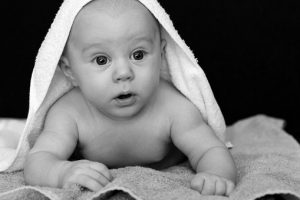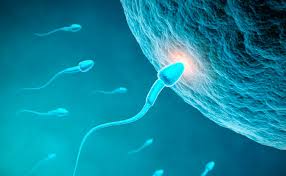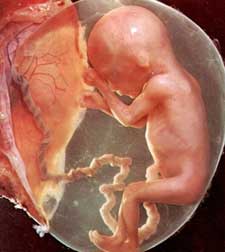conception&embryonicstage
The entire process from an embryo to a baby.
Conception & embryonic stage: ovulation
In a sexually mature girl, approximately every 28 days an egg cell leaves one of her two ovaries on its way to the uterus. This is called ovulation. An egg cell is visible without a microscope: it is about the size of the full stop at the end of this sentence.
Conception & embryonic stage: menstruation
When the egg cell is not fertilized it leaves the body about two weeks later along with cell material on the inside of the womb, which causes a bleeding (menstruation).
Conception & embryonic stage: egg and sperm cells
If semen is present in the woman’s body shortly before ovulation the sperm cells will compete to find and penetrate the egg cell. Sperm cells are much smaller than egg cells, because they only carry hereditary material, while the egg cell carries nutrition as well. If the sperm cell were the size of a little boy, the egg cell would be the size of a house. One ejaculate contains hundreds of millions of sperm cells. They have a long way to go and a lot of them don’t survive the trip through the vagina, the uterus and the fallopian tubes to the ovaries. The sperm cells that get to the egg (with the help of the woman’s internal movements) try to penetrate it. One of them succeeds, upon which the egg becomes impenetrable to the other sperm cells. This is called ‘fertilization’ or ‘conception’.
Conception & embryonic stage: embryo
Once inside the egg cell, the sperm cell moves to the centre and the 23 chromosomes of the two cells link up, so that the fertilized cell contains the 46 chromosomes typical for humans. Approximately one day later the new cell begins to divide, while it continues its way till it arrives at the uterus, where, about 6 days after fertilization, it attaches to the internal surface. In the meantime it has multiplied to several hundreds of cells.
It is now called embryo. The outside layer of cells form the beginning of the placenta and navel cord, which serves as a two way channel of transportation for food and waste.
During the embryonic stage the cells differentiate into three layers: an outer layer, called ectoderm, which will later form the skin, nails, and the nerve system; a middle layer, called mesoderm, which will take care of the skeleton, muscles and blood circulation; and an inner layer, endoderm, which will develop into lungs, digestive system and other internal organs. Animal embryos have the same layers. The early stages of human development show that we are related to other species. For example there is an egg-like structure around the embryo with a space for yolk (which is the food for birds while they are still in the egg). Later, the embryo develops a tail and fishlike gills, which it then loses again. Throughout the early development, the new life is stress-tested. About 15-20 % of pregnancies end in unnoticed abortions, miscarriages or premature births, because the embryo is not strong enough to survive. Sometimes the new being has an adverse effect on the mother, which can lead to sickness and death.
Conception & embryonic stage: pregnancy
During the first two months of pregnancy the main physical functions of the baby are developed: heart and lungs, skeleton, arms, legs and a relatively large head with the beginning of eyes and ears. When this groundwork is laid, the embryo is called ‘foetus’. Its size is about one inch and it weighs only a few ounces, but its mother probably realizes that it is on its way.
An important development is the formation of the sex organs. If the sex chromosome of the foetus is XX, it will develop ovaries, a uterus and a vagina under the influence of the female hormone estrogen, which is already present in the mother’s body. If the foetus has an XY chromosome, it will develop a penis and testicles with the help of the male hormone testosterone, which the mother’s body only produces if the genes on the XY chromosome tell her to do so. Male and female sex organs are very similar in the beginning. The penis develops from the same structure as the clitoris; the testicles from the same structure as the vulva. The female is obviously the older and primary structure of reproduction.
Conception & embryonic stage: foetus
After four months the foetus stretches out, and from then on the mother can feel it kick. After seven months, or 29 weeks, the foetus has developed a layer of fat under its skin, and it weighs over two pounds. If it were born, it would be premature and very vulnerable, but nowadays doctors can keep such babies alive with the help of an incubator, oxygen and tube feeding.
The normal duration of pregnancy in humans is about 9 months, or 38 weeks. When the baby is ready to be born, the mother’s body starts to feel the painful contractions of her uterus. It takes about 13-14 hours for a first child to be born, later children may take only 7-8 hours. A full-term baby weighs about 6 to 8 pounds.
Compared with most other animals, a human baby is very helpless and needs a long period of care to develop. We are born early because our heads are so big that they stretch the vagina to the maximum. After birth our brain and other organs continue to grow as if we were still inside. Our long childhood is required for learning to function as members of a complex society and culture.


